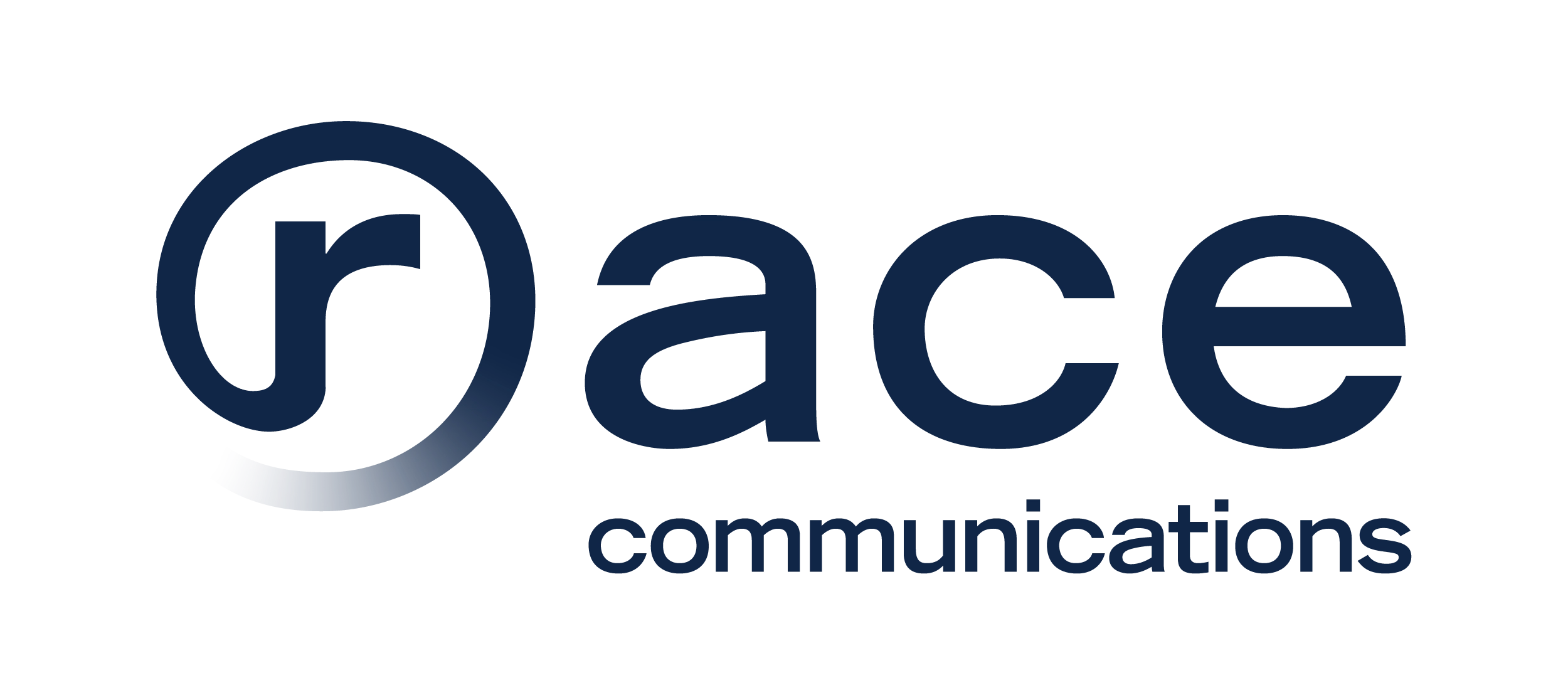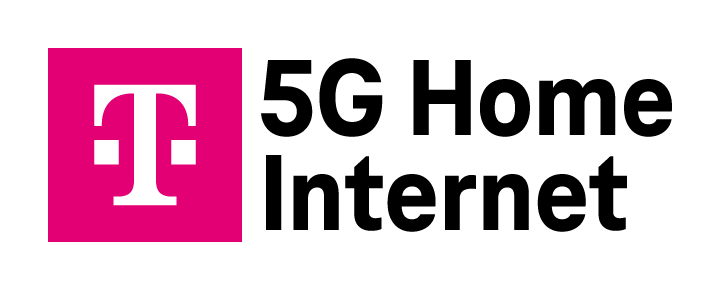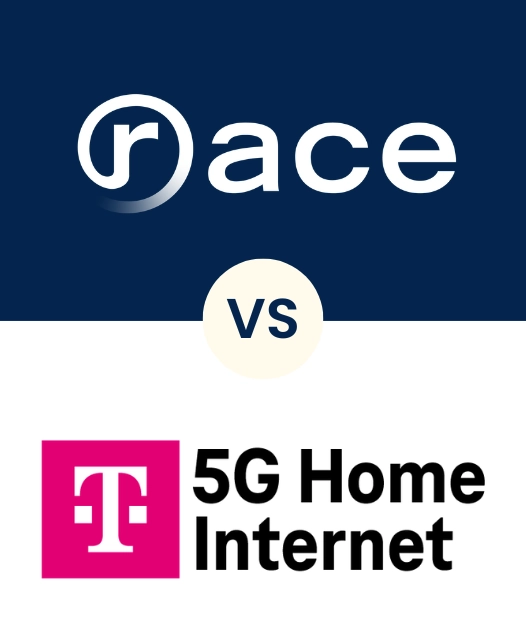Choosing between Race Communications and T-Mobile Home Internet is a choice between fiber-to-the-home (FTTH) and 5G fixed wireless:
- Race delivers 100% fiber-optic service (FTTH) directly to homes
- T-Mobile leverages its 4G/5G wireless network for home internet (fixed wireless access)
Examine their internet technology, plans, pricing, customer satisfaction, and other features to help you decide which is better suited for your home.

1. Internet Technology: Fiber vs Fixed Wireless
Race Communications (FTTH)
A dedicated fiber-optic line runs to your home, moving data as pulses of light. The result: very high bandwidth, ultra-low latency, and rock-solid reliability, even at peak hours.
- Equal download/upload speed, commonly gigabit-class and higher
- Consistent performance not affected by electromagnetic interference; minimal weather impact
- Lowest latency (<10 ms), ideal for video calls, cloud apps, and gaming
T-Mobile 5G Home Internet (Fixed Wireless)
A self-installed 5G/LTE gateway pulls a cellular signal and broadcasts Wi-Fi inside your home. It’s quick to start and widely available. No trenching or technician visit if your address qualifies.
- Fast setup, broad reach
- Variable performance: depends on signal strength, network congestion, and placement
- Typical latency: ~20–50 ms
- Typical speeds: downloads ~50–300+ Mbps; uploads ~10–50 Mbps
- Weather/obstructions can further reduce speeds and stability
| Feature |

|

|
|---|---|---|
| Technology | Fiber-to-the-Home | Fixed wireless (5G/LTE) |
| Max Internet Speeds | Up to 10 Gbps download & upload | Download 50–300+ Mbps; Upload 10–50 Mbps |
| Latency | Often < 10 ms | ~20–50 ms (can vary) |
| Peak Hour Consistency | High | Varies with network congestion |
| Weather Interference | Minimal | Can be affected |
| Installation | Professional installation | Self-installation |
When Fiber Wins (Most of the Time):
- You upload as much as you download (remote work, creators, backups)
- You need lowest latency (gaming, real-time collaboration)
- You want predictable performance at peak times and during bad weather
When Fixed Wireless Makes Sense:
- You need internet now and can’t wait for construction
- You’re in a temporary residence or can’t run new lines
If you want maximum performance and long-term stability, FTTH is the gold standard. If you need a quick start and your coverage is strong, fixed wireless is a convenient stopgap.
2. Race Communications vs T-Mobile: Pricing & Plans
In terms of value, if pure speed is your goal, Race provides more Mbps per dollar.
Both providers offer multiple plan tiers, but the cost-to-speed ratio differs significantly given the technology. Race’s plans are structured by speed (each with a set price), whereas T-Mobile’s plans are structured by a combination of expected speed range and included features.
| Monthly Price |

|

|
|---|---|---|
| ~$45–50 |
Internet 300 300 Mbps download / upload |
Rely Home Internet ~87–318 Mbps down, 14–56 Mbps up |
| ~$60 |
Internet 500 500 Mbps download / upload |
Amplified Home Internet ~133–415 Mbps down, 12–55 Mbps up |
| ~$70 |
Gigabit Internet 1,000 Mbps download / upload |
All-In Home Internet ~133–415 Mbps down, 12–55 Mbps up (includes mesh Wi-Fi unit + streaming perks) |
| $129.95 |
10 Gigabit Internet 10,000 Mbps download / upload |
N/A (T-Mobile tops out around 500 Mbps in ideal conditions) |
Pricing above reflects standard rates; T-Mobile plans may be $5 higher without autopay. T-Mobile also offers a bundle discount: customers with a qualifying T-Mobile mobile phone line save an additional $15–20 per month on Home Internet, bringing net prices as low as $35 for Rely, $45 Amplified, $55 All-In with bundling.
Looking at the comparison, Race’s fiber plans deliver far higher maximum speeds for the price. For roughly $70, Race gives a true 1 Gbps fiber connection, whereas T-Mobile’s $70 All-In plan, while advertised as “400+ Mbps,” in practice is limited by what the 5G signal can deliver (typical 100–400 Mbps range).
Even Race’s mid-tier Internet 500 ($59.90) can exceed the real-world speeds most T-Mobile users will see on any tier. Race’s unique 10 Gigabit plan ($129.95) caters to extreme power-users or home offices that need up to 10,000 Mbps – a level utterly beyond current wireless capabilities.
3. Plan Features
When you’re comparing internet providers, speed and price get all the attention, but the little things can make or break your experience.
Here’s how Race Communications (fiber) and T-Mobile Home Internet (fixed wireless) stack up when it comes to data, contracts, equipment, and extras:
| Feature |

|

|
What it means for you |
|---|---|---|---|
| Data caps | None (unlimited) | None (unlimited) | No usage limits or overage fees. |
| Contracts | No annual contract (month-to-month) | No annual contract | Cancel anytime without early termination fees. |
| Installation & setup fees | $0 professional fiber install (up to $1,000 value) | $0 self-install | Race handles trenching/ONT setup; T-Mobile is plug-and-play via app. |
| Included equipment | Wi-Fi router included + ONT | 5G gateway (modem + Wi-Fi) included | No rental fees. Power users get more flexibility with Race; some T-Mobile gateways lack full bridge mode. |
| Whole-home Wi-Fi | Mesh nodes available: $5/mo per unit (coverage up to ~4,500 sq. ft. with nodes) | Mesh extender included only on top-tier All-In plan | Large homes may need extenders; cost/availability differs. |
| Home phone (VoIP) | Optional add-on (~$10/mo) | Not offered | Choose landline-style service with Race if needed. |
| Extras & perks | Premium install and flexible hardware | Simplicity and quick start; entertainment extras on some plans | Pick based on whether you value pro setup or fastest time-to-internet. |
| Best fit | Builders, gamers, creators, heavy uploaders | Renters, movers, “need internet today” | Performance vs. immediacy, respectively. |
4. Race vs T-Mobile: Customer Sentiment and Support
Specs aside, how do real customers feel about these services? We scanned Reddit, forums, and review sites for on-the-ground feedback.
Race – High-Speed, Problem-Free Fiber Internet
Race is a relatively smaller regional provider, so it doesn’t have thousands of online reviews like big ISPs. However, in the California communities where Race has launched, sentiment is largely very positive regarding the service performance. Early customers often report that the fiber service meets or exceeds expectations.
For example, one user in Lancaster, CA wrote:
“I love Race for the low price and my internet is super fast with no interruptions, slowdowns or outages. Previously, I had Spectrum…and there were occasional lags and outages… I simply love [Race] and am happy to cancel Spectrum.”
Customers also appreciate Race’s fast speeds and value. In Chico, where Race began rolling out in 2024, one resident highlighted:
“Race is offering 1,000 Mb/s (gigabit) for $70 per month… and Race doesn’t have a data cap,”
contrasting it with a more expensive Xfinity’s plan they had before. The fact that Race brings symmetrical gigabit to markets that previously had much slower options is a game-changer for many users, and they express excitement about finally having a fiber alternative.
T-Mobile Home Internet – Depends on the Coverage Area & Congestion
T-Mobile’s Home Internet has a much larger user base nationwide, and feedback is quite varied. On the positive end, a lot of customers (especially those in areas with good 5G coverage) are pleasantly surprised by the service.
Users often report that setup is extremely easy, and that for normal usage like streaming Netflix, Zoom calls, gaming, etc., T-Mobile’s speeds are sufficient. In fact, some users coming from cable or DSL find T-Mobile to be even faster or more responsive at times. For example, one user in Fremont, CA tested T-Mobile 5G against their Comcast connection and wrote:
“I found that 5G was actually faster and more reliable than my cable after a couple days of testing… I get about 300–400 Mbps download and 10–15 Mbps upload reliably.”
However, not all is perfect in wireless-land. By the nature of a cellular network, some users experience fluctuating speeds, especially during peak usage hours or if the local cell tower gets congested.
There are reports on forums of people seeing great speeds at 3AM but much slower in the evening. One Redditor shared:
“Speeds have halved from normal (from ~700 Mbps down to 400 Mbps, and latency worsened) … I had never seen this in the past. There is no congestion here… something is different,”
noting it happened after using over 1.2 TB in a month. This hints that de-prioritization can occur – heavy users might see slower speeds if the network is busy.
Those who expected fiber-like consistency or who live on the edge of coverage can be disappointed. It’s not uncommon to see posts about weird disconnects, needing to reboot the gateway, or having to place it in just the right spot to get a good signal.
Race Communications vs T-Mobile: Final Verdict
At the end of the day, Race Communications vs. T-Mobile Home Internet is choosing 100% fiber vs. 5G.

If your address is in a Race fiber area, the choice is straightforward: go fiber. You’ll get consistently low latency, symmetrical speeds, and rock-solid reliability, exactly what power users, busy households, remote workers, and gamers feel every day. Add free professional installation and local support, and Race is the best long-term value for Californians who want their internet to “just work.
T-Mobile Home Internet is a smart alternative when fiber isn’t available or you need service today. It’s easy, widely available, and often cheaper up front, but performance can vary with signal and congestion.

Leave a Reply